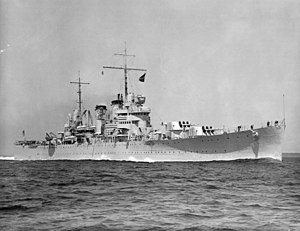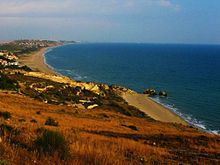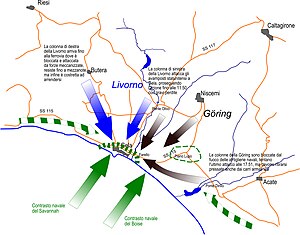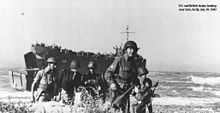
Juno and or Juno Beach was one of five beaches of the Allied invasion of German-occupied France in the Normandy landings on 6 June 1944 during the Second World War. The beach spanned from Courseulles, a village just east of the British beach Gold, to Saint-Aubin-sur-Mer, and just west of the British beach Sword. Taking Juno was the responsibility of the First Canadian Army, with sea transport, mine sweeping, and a naval bombardment force provided by the Royal Canadian Navy and the British Royal Navy as well as elements from the Free French, Norwegian, and other Allied navies. The objectives of the 3rd Canadian Infantry Division on D-Day were to cut the Caen-Bayeux road, seize the Carpiquet airport west of Caen, and form a link between the two British beaches on either flank.

Omaha Beach was one of five beach landing sectors of the amphibious assault component of Operation Overlord during the Second World War.

The Battle of Anzio was a battle of the Italian Campaign of World War II that took place from January 22, 1944. The battle began with the Allied amphibious landing known as Operation Shingle, and ended on June 4, 1944 with the liberation of Rome. The operation was opposed by German and by Italian Repubblica Sociale Italiana (RSI) forces in the area of Anzio and Nettuno.
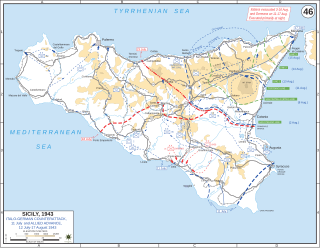
The Allied invasion of Sicily, also known as the Battle of Sicily and Operation Husky, was a major campaign of World War II in which the Allied forces invaded the island of Sicily in July 1943 and took it from the Axis powers. It began with a large amphibious and airborne operation, followed by a six-week land campaign, and initiated the Italian campaign.

Operation Ladbroke was a glider landing by British airborne troops during the Second World War near Syracuse, Sicily, that began on 9 July 1943 as part of Operation Husky, the Allied invasion of Sicily. The first Allied mission using large numbers of the aircraft, the operation was carried out from Tunisia by glider infantry of the British 1st Airlanding Brigade, commanded by Brigadier Philip Hicks, with a force of 136 Hadrians and eight Airspeed Horsas. The objective was to establish a large invasion force on the ground near the town of Syracuse, secure the Ponte Grande Bridge and ultimately take control of the city itself with its strategically vital docks, as a prelude to the full-scale invasion of Sicily.

The Allied invasion of Italy was the Allied amphibious landing on mainland Italy that took place from 3 September 1943, during the Italian campaign of World War II. The operation was undertaken by General Sir Harold Alexander's 15th Army Group and followed the successful Allied invasion of Sicily. The main invasion force landed on the west coast of Italy at Salerno on September 9 as part of Operation Avalanche, while two supporting operations took place in Calabria and Taranto.
Operation Husky order of battle is a listing of the significant military and air force units that were involved in the campaign for Sicily, July 10 – August 17, 1943.

The Battle of Tarakan was the first stage in the Borneo campaign of 1945. It began with an amphibious landing by Allied forces on 1 May, code-named Operation Oboe One; the Allied ground forces were drawn mainly from the Australian 26th Brigade, but included a small element of Netherlands East Indies personnel. The main objective of the landing was the capture of the island's airfield. While the battle ended with success for the Allied forces over the Japanese defenders, this victory is generally regarded as having not justified its costs. The airfield was so heavily damaged that it ultimately could not be repaired in time to make it operational for other phases of the Allied campaign in Borneo.

The Battle of Balikpapan was the concluding stage of Operation Oboe, the campaign to liberate Japanese-held British and Dutch Borneo. The landings took place on 1 July 1945. The Australian 7th Division, composed of the 18th, 21st and 25th Infantry Brigades, with a small number of Netherlands East Indies KNIL troops, made an amphibious landing, codenamed Operation Oboe Two, a few miles north of Balikpapan. The Allied invasion fleet consisted of around 100 ships. The landing had been preceded by heavy bombing and shelling by Australian and US air and naval forces. The Allied force totalled 33,000 personnel and was commanded by Major General Edward Milford, while the Japanese force, commanded by Rear Admiral Michiaki Kamada, numbered between 8,400 and 10,000, of which between 3,100 and 3,900 were combatants. After the initial landing, the Allies secured the town and its port, and then advanced along the coast and into the hinterland, capturing the two Japanese airfields. Major combat operations concluded around 21 July, but were followed by mopping-up operations, which lasted until the end of the war in mid-August. Australian troops remained in the area until early 1946.
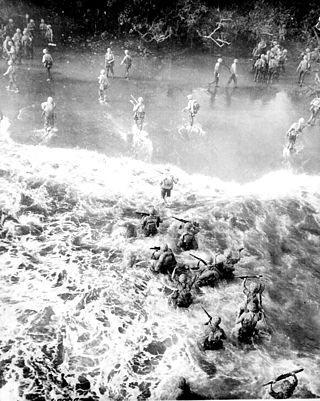
The Battle of Cape Gloucester was fought in the Pacific theater of World War II between Japanese and Allied forces on the island of New Britain, Territory of New Guinea, between 26 December 1943 and 16 January 1944. Codenamed Operation Backhander, the US landing formed part of the wider Operation Cartwheel, the main Allied strategy in the South West Pacific Area and Pacific Ocean Areas during 1943–1944. It was the second landing the US 1st Marine Division had conducted during the war thus far, after Guadalcanal. The objective of the operation was to capture the two Japanese airfields near Cape Gloucester that were defended by elements of the Japanese 17th Division.

The Battle of Biak was part of the Western New Guinea campaign of World War II, fought between the United States Army and the Japanese Army from 27 May to 17 August 1944. Taking place on the island of Biak, in Geelvink Bay, in present-day Indonesia, it was part of General Douglas MacArthur's South West Pacific Area's offensive drive to clear New Guinea in preparation for an invasion of the Philippines. It was the first major effort by the Japanese to allow uncontested landings for the purpose of creating a kill zone inland. The main Allied objective was to capture the island so that they could construct airfields there. The battle resulted in the capture of the island by Allied forces, which were then used to support operations elsewhere in the Pacific.

The Battle of the Kerch Peninsula, which commenced with the Soviet Kerch-Feodosia Landing Operation and ended with the German Operation Bustard Hunt, was a World War II battle between Erich von Manstein's German and Romanian 11th Army and the Soviet Crimean Front forces in the Kerch Peninsula, in the eastern part of the Crimean Peninsula. It began on 26 December 1941, with an amphibious landing operation by two Soviet armies intended to break the Siege of Sevastopol. Axis forces first contained the Soviet beachhead throughout the winter and interdicted its naval supply lines through aerial bombing. From January through April, the Crimean Front launched repeated offensives against the 11th Army, all of which failed with heavy losses. The Red Army lost 352,000 men in the attacks, while the Axis suffered 24,120 casualties. Superior German artillery firepower was largely responsible for the Soviet debacle.

The 4th Infantry Division "Livorno" was a infantry division of the Royal Italian Army during World War II. The Livorno was classified as a mountain infantry division, which meant that the division's artillery was moved by pack mules instead of the horse-drawn carriages of line infantry divisions. Italy's real mountain warfare divisions were the six alpine divisions manned by Alpini mountain troops. The Livorno was formed on 5 April 1939 in Cuneo and named for the city of Livorno.

The Landings on Rendova were amphibious military assaults by United States Army, Marine Corps and Navy forces on Rendova Island in the Solomon Islands on 30 June 1943. The small Japanese garrison was quickly overwhelmed by US troops, but the island was subjected to heavy attack by Japanese aircraft over several days. The landings were some of the first Allied landings during the New Georgia campaign of the Pacific War and were successful in securing the island and providing a base from which the Allies could support the subsequent invasion of New Georgia island and the eventual capture of Munda airfield in early August 1943.
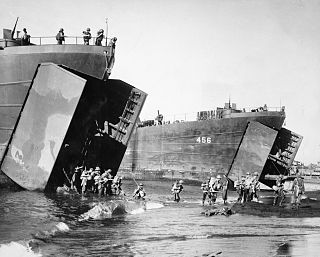
The Landing at Lae was an amphibious landing to the east of Lae and then the subsequent advance on the town during the Salamaua–Lae campaign of World War II. Part of Operation Postern, which was undertaken to capture the Japanese base at Lae, the landing was undertaken between 4 and 6 September 1943 by Australian troops from the 9th Division, supported by US naval forces from the VII Amphibious Force. The first major amphibious operation undertaken by the Australian Army since the failed Gallipoli Campaign, the Australians invested a significant amount of effort into planning the operation.

The invasion of Elba, codenamed Operation Brassard, was part of the Italian campaign during the Second World War. The invasion was carried out from 17 to 19 June 1944 by Free French Forces supported by British and American ships and aircraft. According to the testimony of captured Germans, Allied activity had been observed on Corsica, thus the defenders were aware of the impending invasion 24 hours in advance. They resisted for two days before being given permission to withdraw to the mainland.

The Battle of Finschhafen was part of the Huon Peninsula campaign in New Guinea during World War II and was fought between Australian and Japanese forces. The fighting took place between 22 September and 24 October 1943 following the landing at Scarlet Beach, which was followed by a two-pronged advance on Finschhafen as the Australian 20th Infantry Brigade advanced on the town from the north, while the 22nd Infantry Battalion drove from the south, having advanced from the landing beaches east of Lae. After the capture of Finschhafen, the Japanese forces in the area withdrew towards Sattelberg where they sought to hold the Australians before launching a counteroffensive, which subsequently threatened the landing beach. This attack was repelled by Australian and American forces, with heavy casualties being inflicted on the Japanese. In the aftermath, the Australians went on the offensive, capturing Sattelberg, and then advancing towards the Wareo plateau.

The 115th Light Anti-Aircraft Regiment, Royal Artillery was an air defence unit of the British Army during World War II. Initially raised as an infantry battalion of the East Yorkshire Regiment, it transferred to the Royal Artillery in 1942. It served as the LAA component of the 46th Division in the Tunisian Campaign, at the Salerno landings, and through the Italian Campaign until it was disbanded in 1945.

The 90th Light Anti-Aircraft Regiment, Royal Artillery, was an air defence unit of the British Army during World War II. Initially raised as an infantry battalion of the South Wales Borderers in 1940, it transferred to the Royal Artillery in 1941. It served with 1st Infantry Division in the final stages of the Tunisian Campaign, distinguished itself in the Anzio landings and subsequent fighting, and continued serving in Italy before being disbanded at the beginning of 1945.

The 99th Light Anti-Aircraft Regiment was an air defence unit of the British Army during World War II. Initially raised as an infantry battalion of the Queen's Royal Regiment in 1940, it transferred to the Royal Artillery at the end of 1941. It participated in the assault landings in Sicily and Italy. It then served through the Italian Campaign until it was disbanded in 1944.
